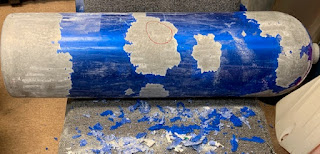Feeling Alive at 165'
 |
| Students Justin Walter (left) and Dan Alix (middle) preparing for Tec 50 open water dives with instructor Bob Bennett Photo: Rose Bennett |
Fred Stratton
Instructor and Technician
fred@bubblesornot.com
fred@bubblesornot.com
 |
| Justin Walter successfully deploys a DSMB in the pool prior to open water work Photo: Tata McNaylor |
TECHNICAL DIVING SERIES PART III
PADI TEC 50 COURSE
Tec 50 takes you beyond your Tec 45 experience by introducing you to the first stages of full technical deep decompression diving. Certified Tec 50 divers are qualified to make multi-stop decompression dives using air, EANx and oxygen (O2) with up to two decompression gases such as 50% Nitrox and 100% O2. You'll plan and execute four dives to a maximum depth of 165' (50 meters).What You'll See Below with Tec Five-Oh
 |
| USS ORISKANY conducting flight operations in 1955 Photo: US Navy |
The ORISKANY being an aircraft carrier, what would a dive on her be without visiting the hangar bay where the Sailors and Marines prepared her warplanes for combat sorties? Your Tec 50 certification will arm you with the skills to peer inside her enormous hangar bay.
The 300-foot long dredger Hydro Atlantic is less than two miles off the coast of Boca Raton, Florida. She rests in 175' of water and rises 55' to 120' (37m) of the surface. Tec 50 divers can enjoy nearly the entire ship. She sank in 1987. Festooned with soft corals she hosts scores of species including formations of jacks that patrol the wreck.
The remains of the Canadian drilling platform J. B. King are spread from 90' (27m) to 160' (48m) in the Saint Lawrence Seaway near Brockville, Ontario. Lightning struck the King in 1930 which ignited dynamite that workers had just placed on the riverbed. Invasive zebra mussels improve visibility at times to 50' and water temperatures are comfortable in the low to mid 70s in the summer. Experiencing the J. B. King is a true adventure, a thrilling technical drift dive in a fast-moving current.
The 206-foot long German freighter Mini-Horn was renamed Miller Lite and sunk as an articifial reef in 165' (50m) south of the Hydro Atlantic in 1987. (Miller Brewing contributed to the project.) Hey Tec 50 divers. This wreck's for you!
What You'll Learn and Do during Tec 50
 |
| Dominic refines his lift bag deployment technique in the pool Photo: Tara McNaylor |
Practical Applications
- Working with one's team divers will rig gear to conform with standardized technical rigging philosophy
- Plan a theoretical technical dive with a single gas switch with up to four deco stops using individual diver gas requirements (SAC rate)
- Divers will include turn points, reserves, oxygen toxicity units and O2 central nervous system (CNS) clock
- Calculate surface air consumption (SAC) rate for bottom and deco times
- Plan a dive using accelerated decompression
Four Open Water Dives
- Dive 1 to a maximum of 30' (9m)
- Dive 2 to between 40' (12m) and 80' (24m)
- Dive 3 to between 100' (30m) and 165' (50m)
- Dive 4 to between 130' (40m) and 165' (50m)
- Self & buddy checks: weighting, bubbles and rigging
- Out of gas using long hose as donor and receiver
- Don and remove stage deco cylinder
- Valve shutdown & regulator switch to address freeflowing regulator
- Primary BCD failure, neutral buoyancy with backup system
- Swim at constant depth for 10 minutes to determine SAC rate
- Deploy lift bag or delayed surface marker buoy (DSMB)
- Switching multi-gas computers
- Gas/depth/time awareness - record depth, time & SPG reading each 15 minutes throughout the dive
- Gas switch to O2 at 20' (6m)
- Air break - switch from deco mix to back gas then back to deco mix
- Post-dive review and critique
 |
| Gas mixes verified? Check. Dive plan verified? Check. S drill complete? Check. Let's dive! Photo: Rose Bennett |
To Enroll in Tec 50 You Will Have
- Earned your Tec 45 Diver certification
- Logged at least 100 dives
- 20 dives on EANx deeper than 60' (18m)
- 15 dives on any gas deeper than 100' (30m)
Coming in April: Trimix 65




Comments
Post a Comment